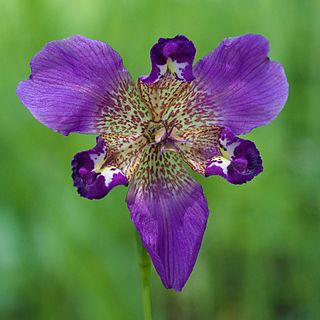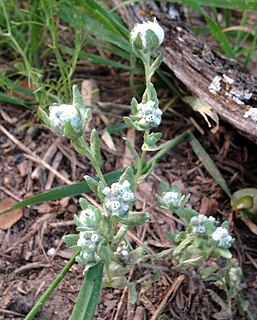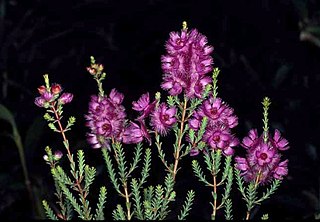
A wildflower is a flower that grows in the wild, meaning it was not intentionally seeded or planted. The term implies that the plant probably is neither a hybrid nor a selected cultivar that is in any way different from the way it appears in the wild as a native plant, even if it is growing where it would not naturally. The term can refer to the flowering plant as a whole, even when not in bloom, and not just the flower.

Allium drummondii, also known as Drummond's onion, wild garlic and prairie onion, is a North American species of onion native to the southern Great Plains of North America. It is found in South Dakota, Kansas, Nebraska, Colorado, Oklahoma, Arkansas, Texas, New Mexico, and northeastern Mexico.

Xyris is a genus of flowering plants, the yelloweyed grasses, in the yellow-eyed-grass family. The genus counts over 250 species, widespread over much of the world, with the center of distribution in the Guianas.

Banksia drummondii, commonly known as Drummond's dryandra, is a species of shrub that is endemic to Western Australia. It has pinnatifid to pinnatisect leaves, heads of up to one hundred cream-coloured, red and yellow flowers and glabrous fruit.

Grevillea drummondii, or Drummond's grevillea, is a shrub which is endemic to the south west region of Western Australia.
Grevillea centristigma is a shrub which is endemic to the south west region of Western Australia.

Alophia is a small genus of perennial, herbaceous and bulbous plants in the family Iridaceae. The genus comprise five known species that occur from the South-central United States as well as in Mexico, Central America, and parts of South America.

Astragalus drummondii is a species of flowering plant in the legume family known by the common name Drummond's milkvetch. The botanist Thomas Drummond first identified the plant during his travels in North America from 1825 to 1835, the year of his death. Accordingly, A. drummondii, amongst many other plants, was named after the late botanist. Upon the return of samples collected by Drummond to England, his findings were published in Sir William Hooker’s Flora Boreali-Americana in 1840.

Diaperia verna, common names spring pygmycudweed, spring rabbit-tobacco or many-stem rabbit-tobacco, is a plant species in the sunflower family, native to northern Mexico and the southern United States.
Solidago drummondii, commonly called Drummond's goldenrod, is a North American species of flowering plants in the sunflower family. It is native to the middle Mississippi Valley of the Central United States, primarily in Missouri and Arkansas but with additional populations in Louisiana and Illinois.
Helenium drummondii is a North American perennial plant in the Sunflower Family, commonly known as fringed sneezeweed. It is native to the south- central United States, in eastern Texas, Arkansas, and Louisiana.
Isocoma drummondii, the Drummond's goldenbush, is a North American plant species in the sunflower family. It has been found on both sides of the Río Grande, in Tamaulipas and in southern Texas.
Xyris drummondii, common name Drummond's yelloweyed grass, is a North American species of flowering plant in the yellow-eyed-grass family. It is native to the coastal plain of the United States from Georgia to eastern Texas.

Verticordia drummondii, commonly known as Drummond's featherflower, is a flowering plant in the myrtle family, Myrtaceae and is endemic to the south-west of Western Australia. It is an erect, openly to densely branched shrub with small, narrow leaves and pink to purple flowers in small heads near the ends of the branches.
Grevillea fuscolutea is a shrub of the genus Grevillea native to a small area along the south coast in the Great Southern region of Western Australia.
Grevillea rara, also known as the rare grevillea, is a shrub of the genus Grevillea native to a small area in the South West region of Western Australia.

Petrophile drummondii is a species of flowering plant in the family Proteaceae and is endemic to southwestern Western Australia. It is a shrub with rigid, pinnate leaves with needle-shaped, sharply-pointed pinnae, and spherical heads of hairy, fragrant, yellow flowers.

Hedeoma reverchonii, commonly called Reverchon's false pennyroyal, is a species of flowering plant in the mint family (Lamiaceae). It is native to the south central region of the United States, where it is primarily found in Texas, extending into small areas of Arkansas and Oklahoma. Its natural habitat is on open, calcareous rock outcrops.

Paronychia drummondii, commonly called Drummond's nailwort, is a species of flowering plant in the family Caryophyllaceae. It is native to the United States where it is restricted to the South Central region in the states of Louisiana, Oklahoma, and Texas. Its natural habitat is in sandy woodlands and openings.

Symphyotrichum drummondii is a species of flowering plant of the aster family (Asteraceae) native to eastern and central North America. Commonly known as Drummond's aster, it is a perennial, herbaceous plant that may reach 120 centimetres high. Each flower head has many tiny florets put together into what appear as one.













